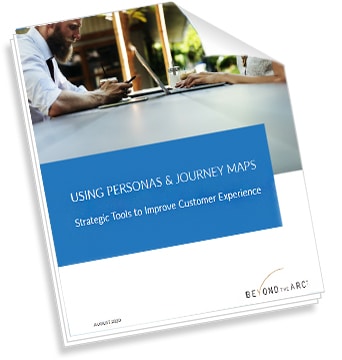complementary white paper
Using Personas & Journey Maps: Strategic Tools to Improve Customer Experience
Most businesses serve a variety of customers, each with different needs, goals, and emotional drivers that influence their actions and decisions. Understanding those differences is key to business success.
Without it, how do you know if you’re delivering the right messages, offers, and actions? How can you target improvements that will have a measurable impact?
Understanding often starts with empathy – and that’s the principle behind customer personas. These strategic tools help you identify unique characteristics of different types of customers, and how that affects their many interactions with your business.
Customer personas in the real world – Industry use cases
How can different industries use customer personas to improve business outcomes? Here’s a look at a few use cases…
Financial Services
Banks and credit unions tend to lump customer personas by product needs or age demographics. But institutions getting it right know that well-defined personas look much deeper to understand how different customers typically behave, and why.
Consider millennials. They may represent a segment, but they’re not a persona. A 40-year old woman who’s a mother, homeowner, and runs her own business will have very different financial concerns and demands than a 28-year old single man. Each may bring a different mindset to every interaction with their bank. Customer personas can help their financial provider better understand those differences, so they can tailor messaging and offers to resonate with specific needs, which helps grow the relationships.
In our work with a top 5 bank, we developed customer personas for travel credit card customers. These tools helped the marketing team understand different types of priorities and expectations, so they could refine product positioning and engagement strategies.
Financial services personas can skew in many ways. For example:
175% increase in marketing-generated revenue and 72% reduction in lead conversion time contributed to using buyer personas.1
- how people at different life stages think about spending, saving, and investing
- how various digital users prefer to resolve issues and get financial advice
- how and why certain customers may be wooed away from a traditional bank by tech giants like Apple, Google, and Amazon who are gaining traction in the financial space
Any of these perspectives could provide insight for improving customer experience.
Healthcare
In recent years, healthcare organizations have been addressing the rising demand to improve the patient experience. Healthcare marketing has grown more challenging as consumers increasingly turn to the internet and social networks to research options and make decisions.
With today’s dominant spotlight on health, customer personas can be especially valuable for understanding the attitudes and motivations of various consumers.
Healthcare is a good reminder that personas don’t need to be complex to be useful. If the organization is insanely busy, they may not have time or resources to create more than a few simple customer personas, such as patient, caregiver, and decision-maker.
Yet, even understanding what’s different about these three segments can help improve how a hospital, private practice, insurance carrier, or medical supply provider might engage with them.
Internet of Things (IoT)
Buyers are 48% more likely to consider solution providers that personalize marketing to address their specific business issues.2
Turning to high tech, complex technology like a B2B IoT platform has many types of users. Industry leaders like Cisco are using personas to understand how to satisfy people in different ways, based on their role.
An IT specialist may be concerned with how to implement and manage the platform for other users. Then comes a lineup of product developers, product managers, operations managers, security specialists, data scientists, and more.
Some of these people will need a deep-dive of what’s under the hood. Many others will be business users who focus less on the technical and more on the value. That’s why it’s important to understand the agendas and nuances of different audiences. It enables the company to improve the product to meet diverse needs, and refine their engagement strategies to focus on what’s most relevant and valuable for different users.
complementary white paper
Using Personas & Journey Maps: Strategic Tools to Improve Customer Experience
Whether your business needs to resolve pain points in the customer journey or uncover opportunities to differentiate, customer personas are an important strategic tool for building buy-in for change and innovation.
For an in-depth look at how to create effective customer personas and use them for journey mapping, download our complementary white paper.
Have questions or curious to explore how personas can help your business?
Let’s start a conversation >
Sources:
1,2 12 Statistics That Prove the Value of Creating Buyer Personas, Protocol80, Inc. August 2015


